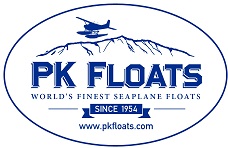PK C3500/4000
FLOAT STRUCTURE
The structural configuration is of conventional aluminum sheet metal design, the side panels are .032” thick with .040 thick bottom and deck skins. There are eight full bulkheads stiffened with bulb angles and hat sections. The forebody bottom is further stiffened by longitudinal extruded hydroboosters. These are effective hat sections riveted on the outside of the skin and greatly increase the strength of the float bottom. In addition, there are partial bulkheads and skin stiffeners fastened at strategic points throughout the entire structure. The keel section is a “Y” shaped extrusion, the bottom of which is 1/2” thick by 1/2” wide running the full length of both forebody and afterbody. This keel section, together with associated structure, is strong enough so that more than one half of the aircraft weight can be supported at one point between bulkheads.
CORROSION PROTECTION
Because of the requirement to use different metals in contact with each other, electrolytic corrosion is a prime enemy of any water-based structure, therefore particular attention is given to the protective finishing materials and procedures to prevent corrosion. All aluminum skins, bulkheads and individual detail parts of the floats are chemically treated and epoxy primed. The faying surfaces of all watertight seams are coated with a urethane adhesive sealant. Following this, the exterior of the floats are cleaned and painted with two coasts of aluminum pigmented lacquer. All aluminum alloy machined parts and extrusions are etched and epoxy primed prior to painting. All steel parts are cadmium plated. Because of the low beam loading and the installation of forward shields, spray heights are comparatively low. Airframe corrosion is, therefore, kept at a lower level than competing installations. For the same reason, propeller blade tip erosion is also kept to a minimum.
MAINTENANCE & REPAIR C3500
The basic C3500 design is completely free of any stretched skins or compound curvatures. The float skins and bulkheads can, therefore, be repaired in the field under emergency conditions with ordinary hand tools.
PERFORMANCE
The hydrodynamic configuration of the float variable deadrise. The float is almost completely free of either upper or lower limit porposing. The high sternpost angle permits short radius turns and sufficient freedom of aircraft rotation at takeoff without dragging the float transoms. The beam (width) of each float is 33.0 inches, which, with the addition of the forward bottom hydroboosters, produces low beam loading. This results in lower spray heights and less drag due to spray impingement on the airframe during takefoff. Rough water operations in are unsurpassed because of the basic deep “V” design of the float. Takeoff from smooth water, under adverse temperature and altitude conditions is superior because of the variable deadrise design and the sharp edged hydroboosters which effectively reduce the beam, and therefore the drag of the wetted area. The forward end of the hydroboosters also are open, permitting air to enter and flow through their full length where it vents the float step and helps break the suction during takeoff.
PK C3500
- Cessna 180A-K, Cessna 185A-E, Cessna A185E, Cessna A185F, Cessna 206-U206G, Turbine 206, Helio H-295
- Max Gross Weight: 3890lbs
- Displacement of one float completely submerged: 3500lbs
- Max Stalling Speed: 65mph
- Hull Length, width, depth: 230”, 33”, 30.1”
- Keel to Keel: 100.5
- Overall Width: 134”
- Cruise Speed: 112kts (C-180), 115kts (C-185)
- Installation Weight: 442lbs
- Height (Top of tail):152.75”
- Baggage Compartment: Optional, 100lbs max
- Number of Watertight compartments: 7
PK 4000
- Cessna 207A, Cessna T207A, Helio 800
- Max Gross Weight: 4433lbs
- Displacement of one float completely submerged: 3990lbs
- Max Stalling Speed: 65.2mph
- Hull Length, width, depth: 264.2”, 32.9”, 30”
- Baggage Compartment: Optional, 100lbs Max
- Number of Watertight compartments: 7


